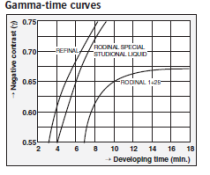- Joined
- Sep 21, 2010
- Messages
- 207
- Format
- Multi Format
Is there a general mathematical relationship to dev time and concentration like there is for temperature and dev time?
For example t=t'*e^(-.045*(T2-T1)) where t' is the original dev time, and T1 is the original temperature given in Fahrenheit. This is usually 68degF.
In chemistry the reaction is defined by the rate equation r=k*[A]^x*^y. Has anyone been able to see this relationship apply in the developing times.
Maybe I can get PE time chime in here.
Thanks,
Chris Maness
For example t=t'*e^(-.045*(T2-T1)) where t' is the original dev time, and T1 is the original temperature given in Fahrenheit. This is usually 68degF.
In chemistry the reaction is defined by the rate equation r=k*[A]^x*^y. Has anyone been able to see this relationship apply in the developing times.
Maybe I can get PE time chime in here.
Thanks,
Chris Maness




